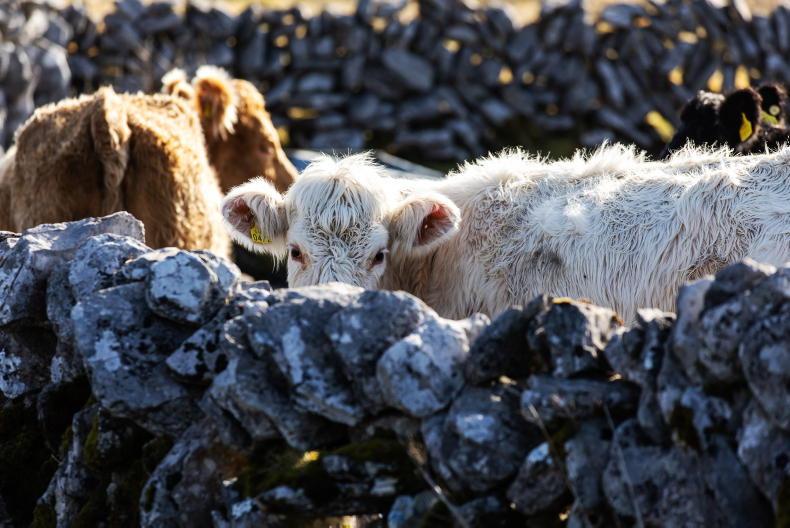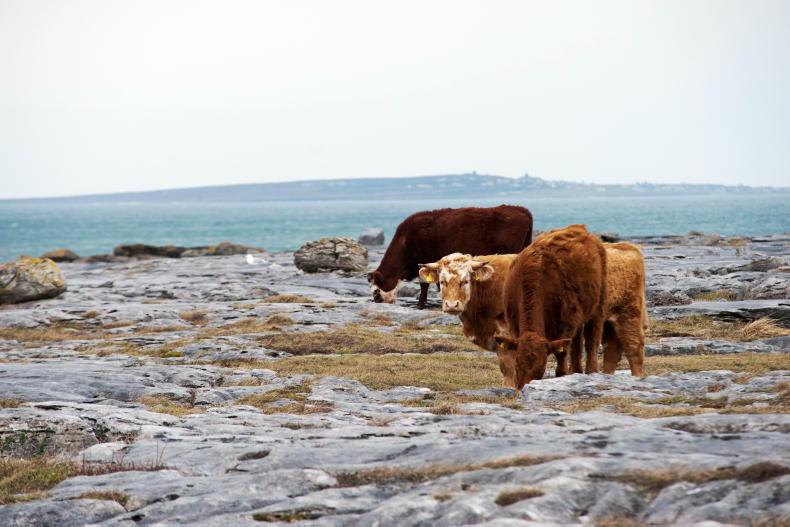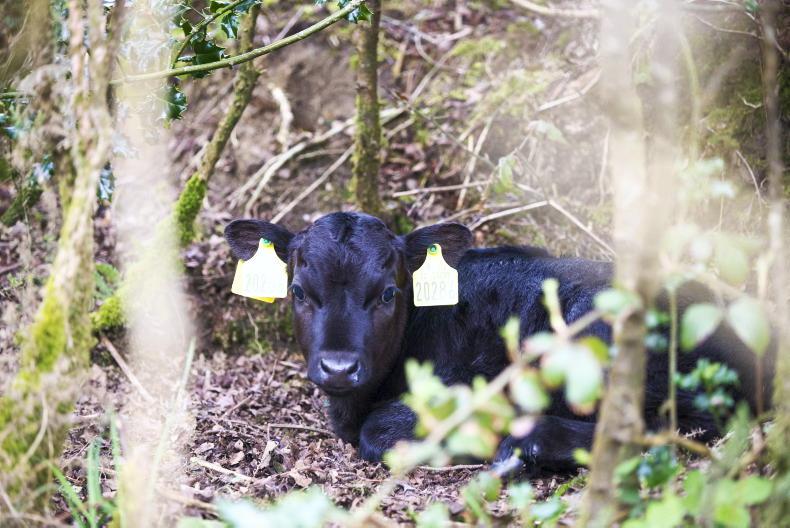The earliest evidence of cattle in Ireland can be dated back to 4000 BC at Ferriter’s Cove, the most western point of the Dingle Peninsula, Co Kerry.
Speaking during a webinar on the history of livestock grazing in Irish uplands, Professor Eugene Costello said these cattle came from the Middle East and continental Europe, with evidence of a small amount of genetic influence from the Auroch cattle of Asia.
The cattle of 4000 BC would have been much smaller than they are today, with mature cow weights of less than 250kg and in many cases only 100kg to 200kg, based on the size of their bones.
Prof Costello said that this started to change in the 1600s, but that it was not until the 1700s and 1800s that cattle breeds in rural Ireland really got big, with weights typical of the animals seen today.
The cattle breeds of ancient Ireland would be similar to the Dexter, Kerry and Droimeann breeds and they would have been dual purpose, he said.
“Often times, a bull was shared among families. Bulls wouldn’t have been that big. These animals were outwintered and they would have lost condition. Then winter was mostly about survival,” he said, adding that it would not have been possible to feed livestock for finishing or to maintain condition over the winter period.
“They might have had the genetics to be big but they would never achieve it,” he explained.
The outwintering of cattle occurred on the lowlands, where grazing might have been saved throughout the year or small saves of hay would have been fed.
With cattle numbers low and much less competition for land, cattle could be moved throughout the winter to avoid excessive poaching.
The environmental history lecturer at University College Cork presented his research on historical Irish cattle as part of this year’s Burren Winterage Festival.
Folklore and law
Prof Costello described how cattle have been embedded in the history, folklore and law of rural Ireland for hundreds of years.
He said that while there is not much evidence of cattle breeding selection by Irish farmers before the 1600s, there is evidence that there was awareness of animal traits and characteristics, which would have been selected for or against.

The first cattle arrived in Ireland in 4000 BC. \ Philip Doyle
“Medieval Irish laws state that cows with known illnesses, bad temperament or inability to stay in-calf were not to be sold. And if they were, the buyer had to be compensated. So, people were clearly aware of certain traits,” he said.
Costello, who is also a suckler farmer near Bruree, Co Limerick, has been studying historical cattle in Ireland for a number of years, with his research ongoing.

Cattle have been grazed on the Burren for hundreds of years. \ David Ruffles
Uplands
The UCC professor honed in on the history of cattle in the Irish uplands, and more specifically, in the Kerry mountains and in the Burren, Co Clare.
“All upland areas would have had cattle in the 1600s. On their highest ground, it would have been just around 700m [above sea level],” he highlighted, adding that there was probably tens of thousands, rather than hundreds of thousands of cattle on the hills.
Prof Costello described a mixed grazing landscape of the Irish uplands, where cattle and goats ran alongside each other, without sheep.
These upland farms were viable for farm families with evidence that enough milk was produced, and butter made, to sell to the lowlands, and further afield for export.
The upland farms of the 1600s with 10 cattle and a few goats were “doing more than getting through,” he said, albeit noting that the enterprises were susceptible to disease outbreaks at times.
Even in the uplands of the Kerry mountains, “dairy cows were the be [all] and end all,” he highlighted, describing how these cows produced milk off the hill.
“I’ve seen legal documents from the 1500s even where it was late spring and early summer and they had in-calf cows,” he said, estimating that the herds would have been almost totally spring calving.
Cows were left to graze the hill during the day and corralled into stone-walled paddocks for milking and at night, to evade the native Irish wolf, which was still present across Ireland at the time.
Even though they were milking them every day, it was common to keep them suckling the calf
Prof Costello demonstrated evidence that these stone wall paddocks had a smaller stone pen in one corner, where cows were cornered for milking, and a smaller again stone store for butter beside that pen.
“Even though they were milking them every day, it was common to keep them suckling the calf,” he said, describing how during milking there was often the farmer at one side of the cow and her calf at the other.

Most cattle were spring-calving. \ Claire Nash
“A lot of the bull calves would have been slaughtered but people didn’t really eat much meat. If beef was eaten, it was usually the bull calf,” he said.
Prof Costello also highlighted that the upland and lowland grazing landscape of Ireland in the 1600s featured woodland and that areas of land were often qualified by their ability to maintain grazing cattle. “Woods worth six cows’ grazing was a standard measure,” he explained.
The UCC lecturer said that woodlands were maintained with cattle and goat grazing in moderation, but that by the end of the 1700s, increasing livestock numbers and the charcoal industry were putting native forestry under pressure.
He shut down the assumption that the arrival of sheep in the Irish hills cleared woodland. “The sheep came into an already deforested landscape. Cattle and goat numbers had been high before. It was kind of always broken before the sheep monoculture came in,” he said.
However, Prof Costello acknowledged that sheep have had their impact on the hills, especially on the lower vegetation, such as heather, that came in after the woodlands.
He said that from pollen analysis, it is clear that there was less woodland in Ireland by the start of the 1800s.
“Woodland was not recovering from the mid-1800s as livestock numbers were increasing,” he added.
The environmental history lecturer suggested that the grazing patterns and upland farm management of ancient Ireland can offer a “blueprint” for how agriculture might meet sustainability targets today.
“Cattle are more likely to create a diverse upland habitat,” he said. However, he maintained that more research is needed on this, suggesting that “there needs to be a 20-year experiment to really test are they better”.

Upland cattle farming offered a viable living for farm families.
Prof Costello insisted that the correct livestock numbers are crucial to any new upland grazing system which might be developed.
“The long-term view on livestock numbers is important.
“At what point do livestock numbers increase to where woodland becomes non-viable?” he asked.
He said that Ireland must adopt an emphasis on area-specific and tailored plans for farming, which take into account the opportunities and constraints within a given landscape.
“The presence of trees and cattle is not at odds with upland farming,” he insisted, using examples from the Swiss Alps as a demonstration of how rural communities can be maintained through upland dairying, with forestry plotted within and between farms.
“Cattle farming in the uplands of the past offers a well of knowledge. It’s more about plucking lessons from the past and maybe looking at livestock numbers,” Prof Costello concluded.
Terms of ancient cattle farming
Booleying: a system of farming which stems from the Irish word ‘buaile’, meaning ‘livestock enclosure’ or ‘milking-place in summer pasturage’. It involved farming cattle between two places and was last practised on Achill Island in the 1940s, having died out in the rest of the country over the course of the 1800s.
Doire na Bláiche (Co Kerry): Oakwood of the Buttermilk.
Doirín na nÁiríoch (Co Kerry): little Oakwood of the Herders.
The earliest evidence of cattle in Ireland can be dated back to 4000 BC at Ferriter’s Cove, the most western point of the Dingle Peninsula, Co Kerry.
Speaking during a webinar on the history of livestock grazing in Irish uplands, Professor Eugene Costello said these cattle came from the Middle East and continental Europe, with evidence of a small amount of genetic influence from the Auroch cattle of Asia.
The cattle of 4000 BC would have been much smaller than they are today, with mature cow weights of less than 250kg and in many cases only 100kg to 200kg, based on the size of their bones.
Prof Costello said that this started to change in the 1600s, but that it was not until the 1700s and 1800s that cattle breeds in rural Ireland really got big, with weights typical of the animals seen today.
The cattle breeds of ancient Ireland would be similar to the Dexter, Kerry and Droimeann breeds and they would have been dual purpose, he said.
“Often times, a bull was shared among families. Bulls wouldn’t have been that big. These animals were outwintered and they would have lost condition. Then winter was mostly about survival,” he said, adding that it would not have been possible to feed livestock for finishing or to maintain condition over the winter period.
“They might have had the genetics to be big but they would never achieve it,” he explained.
The outwintering of cattle occurred on the lowlands, where grazing might have been saved throughout the year or small saves of hay would have been fed.
With cattle numbers low and much less competition for land, cattle could be moved throughout the winter to avoid excessive poaching.
The environmental history lecturer at University College Cork presented his research on historical Irish cattle as part of this year’s Burren Winterage Festival.
Folklore and law
Prof Costello described how cattle have been embedded in the history, folklore and law of rural Ireland for hundreds of years.
He said that while there is not much evidence of cattle breeding selection by Irish farmers before the 1600s, there is evidence that there was awareness of animal traits and characteristics, which would have been selected for or against.

The first cattle arrived in Ireland in 4000 BC. \ Philip Doyle
“Medieval Irish laws state that cows with known illnesses, bad temperament or inability to stay in-calf were not to be sold. And if they were, the buyer had to be compensated. So, people were clearly aware of certain traits,” he said.
Costello, who is also a suckler farmer near Bruree, Co Limerick, has been studying historical cattle in Ireland for a number of years, with his research ongoing.

Cattle have been grazed on the Burren for hundreds of years. \ David Ruffles
Uplands
The UCC professor honed in on the history of cattle in the Irish uplands, and more specifically, in the Kerry mountains and in the Burren, Co Clare.
“All upland areas would have had cattle in the 1600s. On their highest ground, it would have been just around 700m [above sea level],” he highlighted, adding that there was probably tens of thousands, rather than hundreds of thousands of cattle on the hills.
Prof Costello described a mixed grazing landscape of the Irish uplands, where cattle and goats ran alongside each other, without sheep.
These upland farms were viable for farm families with evidence that enough milk was produced, and butter made, to sell to the lowlands, and further afield for export.
The upland farms of the 1600s with 10 cattle and a few goats were “doing more than getting through,” he said, albeit noting that the enterprises were susceptible to disease outbreaks at times.
Even in the uplands of the Kerry mountains, “dairy cows were the be [all] and end all,” he highlighted, describing how these cows produced milk off the hill.
“I’ve seen legal documents from the 1500s even where it was late spring and early summer and they had in-calf cows,” he said, estimating that the herds would have been almost totally spring calving.
Cows were left to graze the hill during the day and corralled into stone-walled paddocks for milking and at night, to evade the native Irish wolf, which was still present across Ireland at the time.
Even though they were milking them every day, it was common to keep them suckling the calf
Prof Costello demonstrated evidence that these stone wall paddocks had a smaller stone pen in one corner, where cows were cornered for milking, and a smaller again stone store for butter beside that pen.
“Even though they were milking them every day, it was common to keep them suckling the calf,” he said, describing how during milking there was often the farmer at one side of the cow and her calf at the other.

Most cattle were spring-calving. \ Claire Nash
“A lot of the bull calves would have been slaughtered but people didn’t really eat much meat. If beef was eaten, it was usually the bull calf,” he said.
Prof Costello also highlighted that the upland and lowland grazing landscape of Ireland in the 1600s featured woodland and that areas of land were often qualified by their ability to maintain grazing cattle. “Woods worth six cows’ grazing was a standard measure,” he explained.
The UCC lecturer said that woodlands were maintained with cattle and goat grazing in moderation, but that by the end of the 1700s, increasing livestock numbers and the charcoal industry were putting native forestry under pressure.
He shut down the assumption that the arrival of sheep in the Irish hills cleared woodland. “The sheep came into an already deforested landscape. Cattle and goat numbers had been high before. It was kind of always broken before the sheep monoculture came in,” he said.
However, Prof Costello acknowledged that sheep have had their impact on the hills, especially on the lower vegetation, such as heather, that came in after the woodlands.
He said that from pollen analysis, it is clear that there was less woodland in Ireland by the start of the 1800s.
“Woodland was not recovering from the mid-1800s as livestock numbers were increasing,” he added.
The environmental history lecturer suggested that the grazing patterns and upland farm management of ancient Ireland can offer a “blueprint” for how agriculture might meet sustainability targets today.
“Cattle are more likely to create a diverse upland habitat,” he said. However, he maintained that more research is needed on this, suggesting that “there needs to be a 20-year experiment to really test are they better”.

Upland cattle farming offered a viable living for farm families.
Prof Costello insisted that the correct livestock numbers are crucial to any new upland grazing system which might be developed.
“The long-term view on livestock numbers is important.
“At what point do livestock numbers increase to where woodland becomes non-viable?” he asked.
He said that Ireland must adopt an emphasis on area-specific and tailored plans for farming, which take into account the opportunities and constraints within a given landscape.
“The presence of trees and cattle is not at odds with upland farming,” he insisted, using examples from the Swiss Alps as a demonstration of how rural communities can be maintained through upland dairying, with forestry plotted within and between farms.
“Cattle farming in the uplands of the past offers a well of knowledge. It’s more about plucking lessons from the past and maybe looking at livestock numbers,” Prof Costello concluded.
Terms of ancient cattle farming
Booleying: a system of farming which stems from the Irish word ‘buaile’, meaning ‘livestock enclosure’ or ‘milking-place in summer pasturage’. It involved farming cattle between two places and was last practised on Achill Island in the 1940s, having died out in the rest of the country over the course of the 1800s.
Doire na Bláiche (Co Kerry): Oakwood of the Buttermilk.
Doirín na nÁiríoch (Co Kerry): little Oakwood of the Herders. 









 This is a subscriber-only article
This is a subscriber-only article










SHARING OPTIONS: